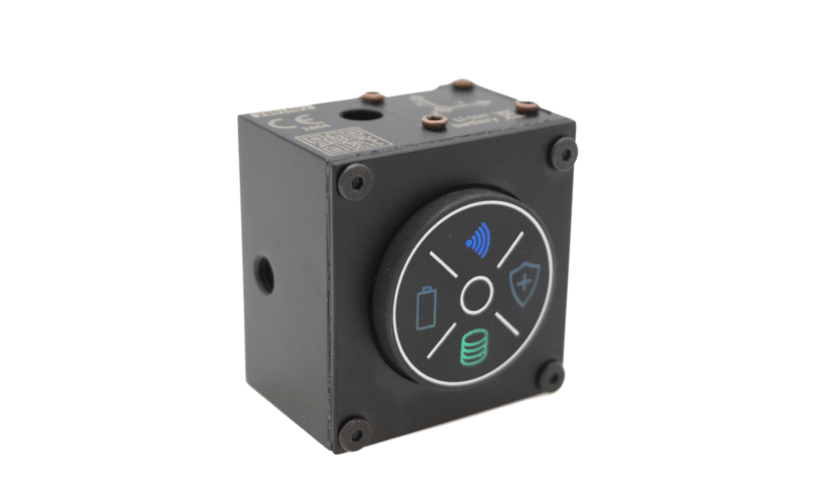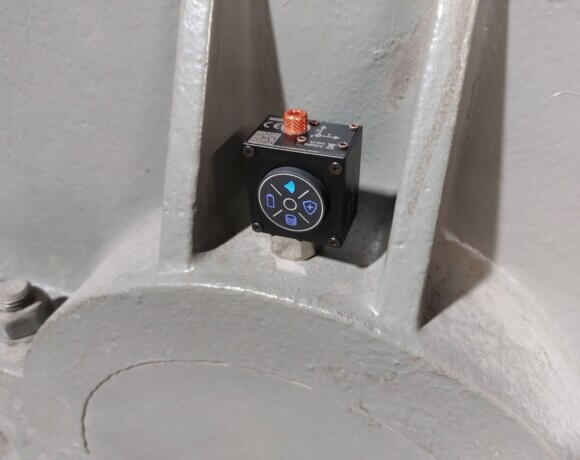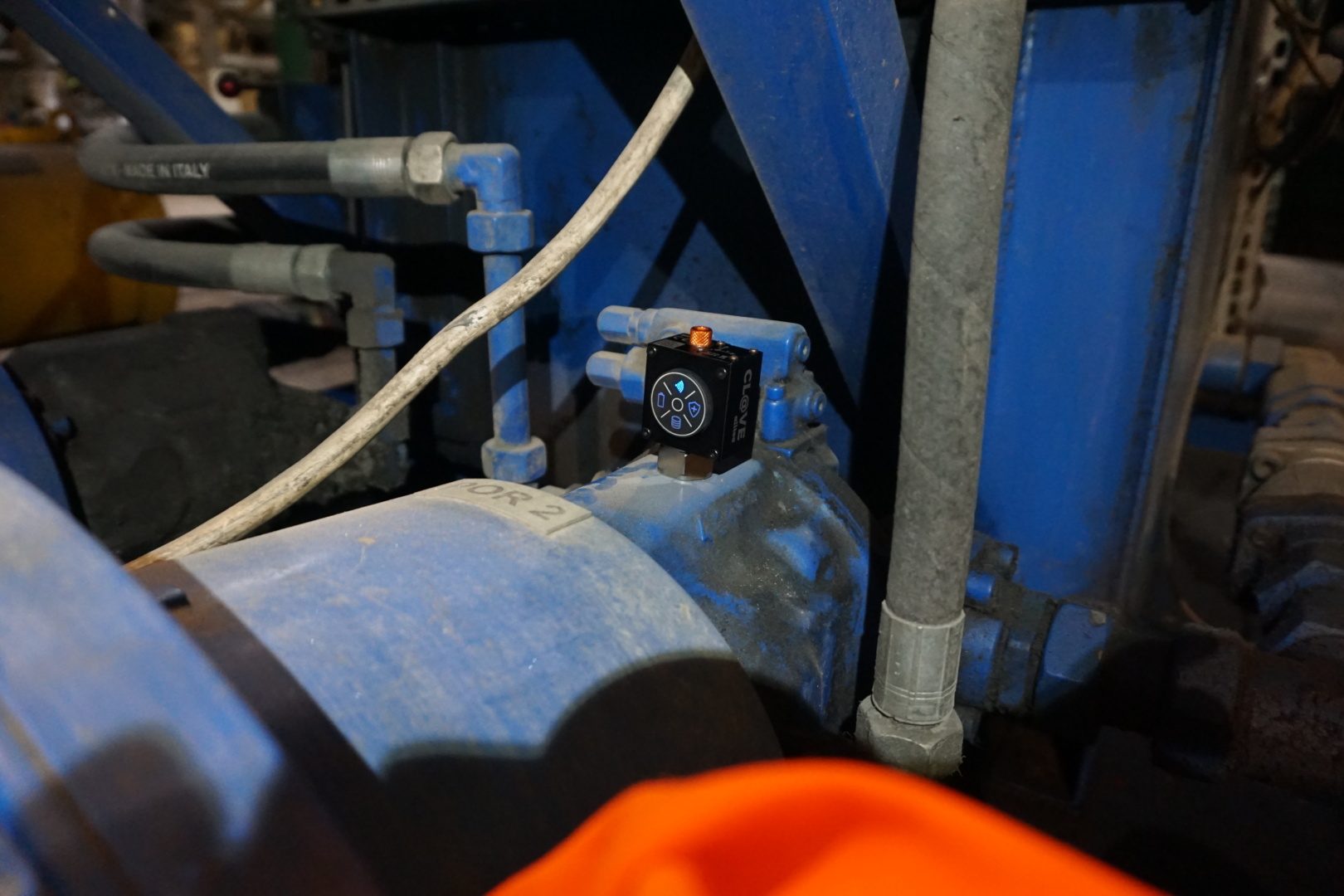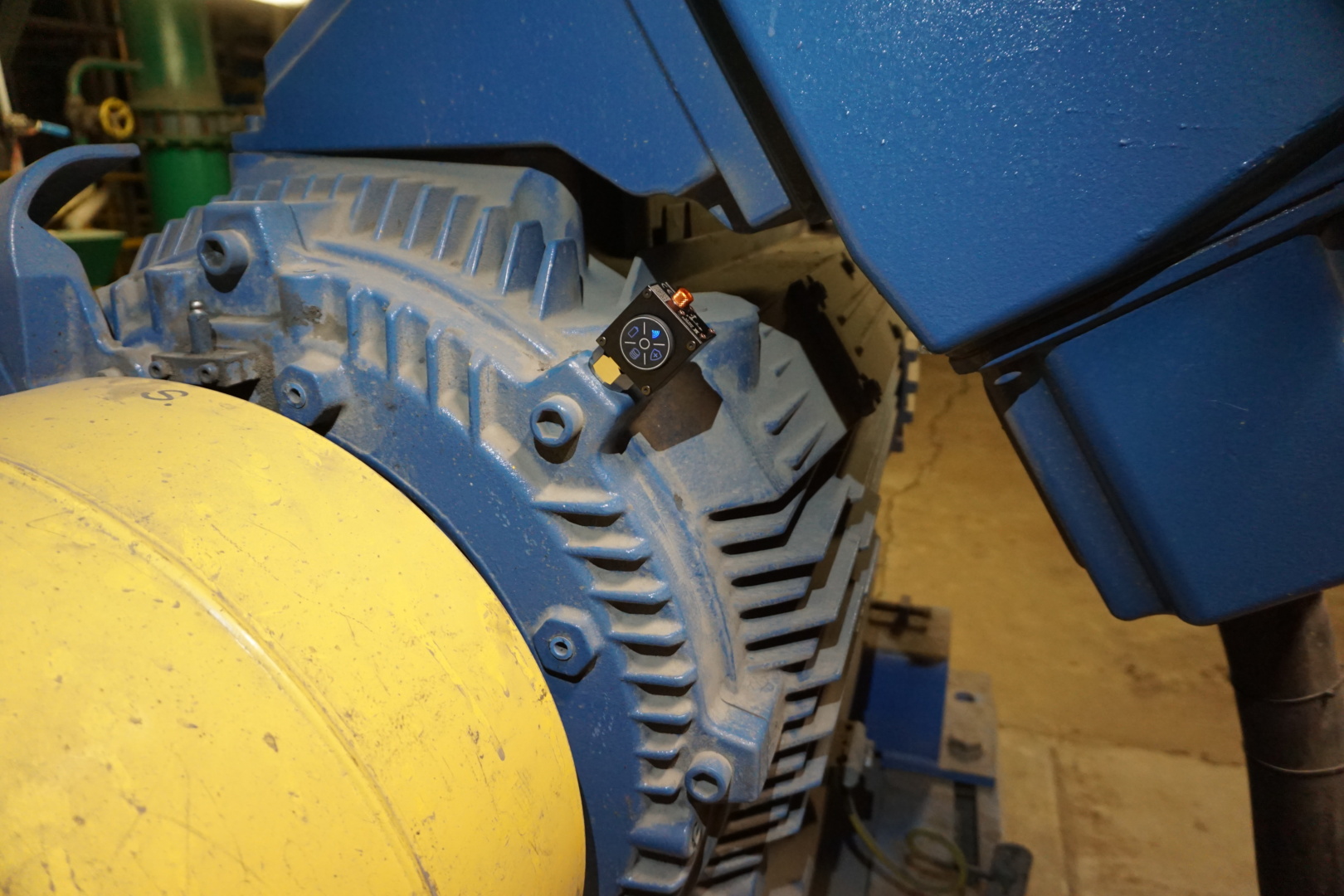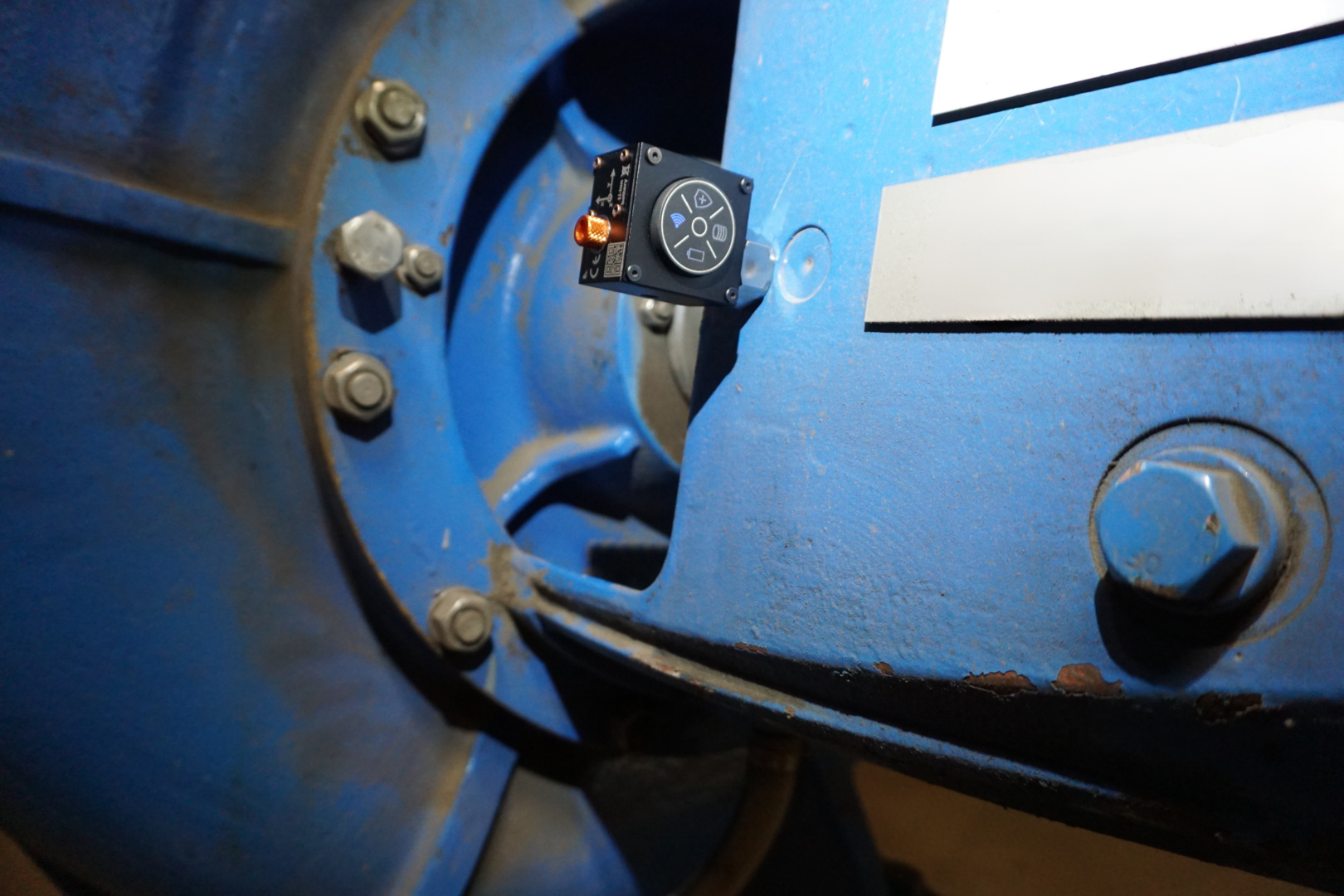CL@VE CLAVE
CL@VE is a unique device intended for evaluating the overall technical condition of machine components and avoiding unexpected failures. This compact sensor records and analyzes 3D vibrations, sound, ultrasound, alternating magnetic fields, rotational speed, and temperature. The built-in functions and interfaces will surprise you with the multitude of ways and applications in which you can use it!
Connected to your smartphone or the VIDIA diagnostic cloud, it adapts to your level of experience. Initially, it serves as a simple wireless vibration sensor. As you gain expertise, you’ll discover its potential as a powerful instrument for multi-domain fault diagnosis of machine components and failure prediction.
The software working with CL@VE optimizes the data collection and analysis process. However, daily challenges may limit the time you can dedicate to investigating and analyzing machine conditions. In such cases, installing an appropriate number of CL@VE sensors at key points on the machine allows them to send information about the condition of its components to the automation system. When you notice any concerning changes, you can retrieve the measurement results (vibration levels) from the sensors’ memory, which can then be handled by an expert. Optionally, CL@VE can send signals directly to the cloud, notifying you when the machine condition deteriorates.
CL@VE finds applications in various industrial plants, delivering results that lead to improvements in the efficiency and effectiveness of maintenance teams. Users of the solution (machine health monitoring) have confirmed significant increases in machine availability and reductions in production losses.
If you’re a diagnostician or service technician, you can provide CL@VE to the plants you work with, eliminating the need for unnecessary travel. Utilizing the VIDIA.cloud or VIDIA.server (vibration sensor monitoring applications) environment enhances the efficiency of your work. Marked with unique QR codes magnetic bases placed at measurement points along with mVIDIA mobile software functions ensure accurate signal recording by engineering team. The results are transmitted to the cloud or to a server (wireless system). The signals are automatically processed and compared to the condition assessment criteria. You can remotely perform detailed machine damage diagnostics. By utilizing online solutions, you receive immediate notifications about emerging alarms via SMS and/or email.
Despite its small size, it stands out due to its technical parameters
- Basic MEMS 3D accelerometer (mems vibration sensors) with ±16 g measurement range, frequency band from 0 to 6.4 kHz
- High frequency 1D MEMS accelerometer (mems vibration sensors) with high accuracy, ±50 g measurement range, frequency band from 0 kHz to as high as 15 kHz
- MEMS microphone sensitive to audible sounds and ultrasonic waves covering 15 Hz to 51.2 kHz
- Magnetic flux sensor with a measurement range of ±3 T and frequency range up to 10 kHz
- Temperature sensor which measures the sensor temperature within a range of -30 to +110 °C
- Digital input for rotation or phase sensor
- Memory for measurement and analysis results with capacity of 8 GB
- Li-Ion battery with capacity of 1200 mAh
- Wi-Fi and Ethernet interfaces with Modbus/TCP
- Wireless interface for sensor cloud synchronization (option available from 08.2024)
- 4-20 mA analog output
- 2 digital outputs
CL@VE is all about application versatility
- It integrates the highest quality transducers to guarantee predictive performance and works as:
– IoT sensor: Direct transmission of integrated sensor signals to a smartphone or server
– Machine condition monitor: Three alarm thresholds for each of 24 parameters, alarm output, integration with control system
– Signal recorder: Built-in 8GB memory (for sensor data).
- Perfectly suited for workaround diagnostics (off-line) as well as for continuous supervision (on-line)
- Self-determines diagnostic parameters (function available from 06.2024)
- Communicates via wireless Wi-Fi and wired ETHERNET/PoE interface
- Can send signals directly to the diagnostic cloud or to a server
- Powered by a rechargeable battery, it can work for up to 3 years
- Can be a part of the automation control system and share information about the current technical condition machine components (relay output, analog output, MODBUS/TCP)
- The software it cooperates with stores the entire history of measurements as raw signals, which allows you to calculate any diagnostic parameters at any time
DiBOX
Available software 
mVIDIA is an application, whose functionality will fulfill the needs of not only experienced experts but also it will help persons who just start their adventure with vibration measurement to learn predictive maintenance secrets.
Everyday tasks of maintenance service can be performed very effectively thanks to the set of analyses, which has been developed in cooperation with experts and intuitive graphical user interface
Machine diagnostics environment VIDIA. Depending on the needs, it is installed on a PC or servers with remote access to measuring devices and a database. It supports communication with all Alitec measuring devices. It has unique functionality in the field of technical condition assessment and machine diagnostics tools, covering various levels of advancement.
There are plants where there are no abrupt stops in production lines. This level of dependability is reached by teams who constantly monitor the technical status of machines and detect the earliest signs of growing harm. Repairs are completed during process downtime or maintenance shutdowns. If you want to take control of breakdowns, you’ll need a dependable, trusted instrument. In the midst of daily chores, the convenience of use and automation of data gathering, and analysis will be critical for you. Given the wide range of equipment and accompanying difficulties, you will be concerned about the solution’s versatility and scalability. That’s exactly what CL@VE is.
Vibration levels rise when machinery’s moving parts are damaged or not adequately oiled. Characteristic patterns enable you to identify different types of damage and correlate them with certain machine parts. A machine health monitoring (vibration analysis), you may estimate when a machine will halt due to a fault. CL@VE captures the vibration signal using two sensors with varying settings. Both are low-noise acceleration sensors built with microelectromechanical systems (MEMS vibration sensors) technologies. CL@VE basic INDUSTRIAL version is appropriate for evaluating the overall technical condition of machine components. You may readily compare the findings to the criteria outlined in the standards. Measuring systematically will result in a faster growth in the levels of the measured values. It will indicate wear on the monitored machine components. Using a vibration range of ±16 g and a maximum frequency of 6.4 kHz, you may spot typical defects such as: unbalance and eccentricity of rotors, shaft misalignment, mounting clearances and cracks in machine components, damage and misalignment of gear wheels and gear belts, damage and dirt on turbines and fans, electrical damage to motors, critical speeds, resonances.
The simple accelerometer (wireless vibration sensor) detects vibrations in 3D space. Before beginning to measure, consult the handbook. In it, we explain how to mount the CL@VE and use the omni-directional sensor.
You can enhance your basic version of wireless sensor by enabling additional features.
The SOUND license activates a built-in acoustic transducer with a measurement range of 15 Hz to 51.2 kHz. It will be used in the low-frequency region to measure noise levels and perform vibroacoustic testing. Ultrasonic analysis is said to be the oldest approach for detecting bearing lubrication deterioration or damage. Ultrasonic measurements will help you locate leaks in compressed gas systems. If cavitation is present in your machinery, the SOUND option will allow you to determine its severity. This license is worth looking into if you need to detect incomplete discharges in insulators, transformers, or drives.
The built-in magnetic field strength sensor is highly sensitive, allowing it to determine world directions. However, this application was not the most crucial to us. The magnetometer responds to field variations of up to 10 kHz. With its assistance, you will examine the recurrence of the magnetic flux emitted by the separate windings of a drive or power generator. An unbalanced image suggests damage or difficulties with the power circuitry. Using the magnetic field sensor, you will measure the drive’s rotating speed and incorporate it into the vibration spectrum studies, looking for distinctive fault frequencies.
You can utilize the CL@VE as a mobile device for workaround diagnostics. Your smartphone or tablet, running the mVIDIA or MADI software (vibration sensor monitoring applications), will then serve as the user interface. Stick-on stands fastened to the machine bearing housings ensure that the sensor is magnetically attached and aligned in 3D space. An distinct QR code or NFC tag placed on each cradle will immediately direct you to the measuring location at where you are located. The measurement findings will be routed to the appropriate location in the plant structure of the VIDIA.cloud or VIDIA.server environments. You simply need to take one measurement at each point (e.g. vibration analysis). The software will pick the sensor settings such that all of the required parameters are counted. You don’t have to worry if you forget to perform an analysis. You can easily do it later; all source signals will be recorded on your mobile device and transmitted to the cloud in real time. The sensor’s built-in Li-Ion rechargeable battery allows you to use it for an average of 10 hours with rounds of diagnostics. Advanced power-saving algorithms in walk-around measurements extend this time to a few hours.
If the system under examination is functioning in fluctuating conditions or damage symptoms arise at random, you can leave CL@VE unattended for an extended period of time. Look for the ACQUIRE licence, which includes 8 GB of built-in data memory. Once the logging parameters are set, the sensor will wake up at the appropriate time to gather time waveforms (sensor data) from all sensors. If you give continuous network connectivity, the results will be sent to the VIDIA server without your input. If you do not have network access at the measurement location, bring CL@VE with you and connect it to the server using the network in your workplace.
The MONITOR license will undoubtedly prove useful in wireless sensor stand-alone operation. Once enabled, the sensor will begin to determine the diagnostic parameters you have selected. This ensures that the plant’s most vital objects are constantly observed (machinery health). When alarm thresholds are exceeded, CL@VE activates the built-in relay and sends measurement data to the server immediately. If you use VIDIA.cloud, the system will notify you of an emergency via SMS and/or email.
The CL@VE with an active MONITOR licence will work seamlessly with your plant’s automation systems, which you are just introducing to the realm of Industry 4.0. In addition to the WiFi wireless interface (which can be disabled), the sensor has a wired network card that supports PoE (Power over Ethernet) and Modbus/TCP communication. Once linked into the network architecture, CL@VE will communicate the specified parameters to the automation system, which will evaluate the status of chosen machine components. The acquired results, along with the alarms, will be presented on the synoptic panels and used to improve plant operations management. Remember that in the event of an alarm, you can still communicate the measurement results stored in the sensor memory to the VIDIA environment and perform (or have performed) a thorough problem diagnostic.
If you are monitoring equipment with varying cycles or speeds, use a rotation or position sensor to trigger the measurement. You’ll attach it to the CL@VE digital input.
CL@VE will soon be used in conjunction with a wireless laser shaft angle sensor for multi-plane rotor balancing in own bearings. We are working on a related application.
| Sensor types and measurement ranges | MEMS 3D vibration acceleration sensor: • measuring range maximum ±16 g • frequency band 0 ÷ 6.4 kHz • noise level up to 75 μg/√Hz for ±2 g range MEMS 1D vibration acceleration sensor for Z direction (optional): • measuring range ±50 g • frequency band 0 ÷ 15 kHz • noise level up to 25 μg/√Hz for ±50 g range MEMS microphone: • Frequency bandwidth of at least 15 Hz ÷ 51 kHz • 120 dB SPL (20 Pa) • signal-to-noise interval for the beginning of the ultrasonic band (19 kHz) at least 76 dB Magnetic field strength sensor: • measuring range 3T • resolution of 0.01 mT • frequency range 10 kHz Temperature sensor: • measuring range -30 ÷ +110 °C |
| Wireless communication | Interface IEEE 802.11b/g/n Wi-Fi, WPA2 Frequency range 2.4 to 2.4835 GHz, maximum transmitted power 19.5 dBm@11b, 16.5 dBm@11g, 15.5 dBm@11n |
| Wired communication interface | IEEE 802.3af/at Ethernet 10/100Base-TX (PoE) |
| Communication protocols | Modbus/TCP, ATC MESbus |
| Software | mVIBE, mVIDIA, datACQUIRE, VIIA.cloud, VIDIA.server Optional: APIs, Matlab control functions, software functions customized to the application |
| Working and storage conditions | Temperature -10 . +70 °C with Li-Ion battery temperature -20 . +90 °C with Li-SOCl battery2 humidity: 10..100% RH |
| Degree of protection | IP67, dustproof housing, resistant to immersion in water (with protected microphone channel) |
| Power supply | Replaceable Li-Ion 3.7V/1200mAh battery with integrated 5V/550mA charger Alternatively: Li-SOCl battery2 3.6V/2100mAh Built-in advanced power saving mechanisms and battery protection against overload or complete discharge |
| Assembly | with an M6 screw at least 47mm long |
| Geometric dimensions and weight | 40 x 42 x 27 mm (SxWxG), 110 g |


